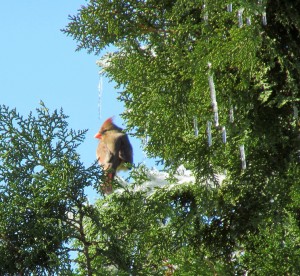By
Kathleen Mack, Indian Trail Master Naturalist
My bird feeder has had a steady stream of customers during the recent ice storm. Have you ever wondered how birds that choose to winter over instead of migrate keep warm?
Birds actually have a number of methods that they use. Fluffing is one of the common techniques. The birds simply create an air space between their feathers, which is like putting on an extra jacket. They may also huddle, stand on one leg, or shiver. Birds also have the ability to lower their body temperature (hypothermia), which often helps them survive long cold winter nights.
Cover and energy are also important, and that is where human beings can be helpful. Birds need three things to survive: shelter, food and water. When providing food it is important to offer high-energy seed. Sunflower and Nyjer seed are both good options. Suet should be on the list as well. Covering a pine cone in peanut butter and bird seed is a sure winner. Just remember that once you start feeding the birds you need to continue, because your feathered friends will quickly learn to depend on you.
Shelter in the form of evergreen trees is also great or you can place birdhouses in sheltered locations.
Lastly make sure there is plenty of fresh water available. A heated birdbath is ideal, but you can improvise. Any dish with a rim for the birds to perch on will work. Just remember to refill it often since the water will freeze.
Do you think nature should be part of our everyday life, not just somewhere to go on the weekends? You are invited to attend our free, open-to-the-public, monthly program on the fourth Monday of the month at 7 pm at the First United Methodist Church, Waxahachie, TX. For more information on the Indian Trail Master Naturalist Chapter, contact the Texas A & M AgriLife Extension Service at 972-825-5175 or visit our website: http://txmn.org/indiantrail/.



